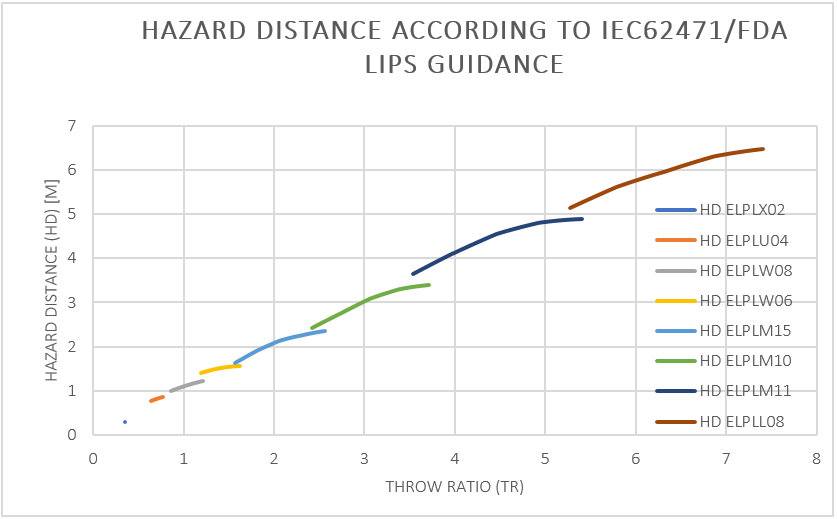Hazard Distance (HD) is the distance measured from the projection lens at which the intensity of the energy per surface unit becomes lower than the applicable exposure limit on the cornea or on the skin. To prevent risk of eye or skin exposure, no person should enter the area within the HD of the projector during operation.
The HD depends on the number of lumens produced by the projector, the size of the panel(s) used, and the type of lens installed. HD values are provided in the table below.
To protect untrained end users (such as cinema visitors or spectators), the installation shall comply with the following installation requirements: Operators shall control access to the beam within the hazard distance or install the product at the height that will prevent spectators from being in the hazard distance. Radiation levels in excess of the limits will not be permitted at any point less than 2.0 meters (SH) above any surface upon which persons other than operators, performers, or employees are permitted to stand or less than 1.0 meter (SH) lateral separation from any place where such persons are permitted to be. In environments where unrestrained behavior is reasonably foreseeable, the minimum separation height should be greater than or equal to 3.0 meters to prevent potential exposure, for example by an individual sitting on another individual’s shoulders, within the HD.
These values are minimum values and are based on the guidance provided in IEC 62471-5:2015 section 6.6.5.
The installer must understand the risk and apply protective measures based upon the hazard distance as indicated on the label and in the user information. Installation method, separation height, barriers, detection systems or other applicable control measures shall prevent spectator access to the projected light within the hazard distance.
For example, projectors that have a HD greater than 1 meter and emit light into an uncontrolled area where persons may be present should be positioned in accordance with “the fixed projector installation” parameters, resulting in a HD that does not extend into the audience area unless the beam is at least 2.0 meters above the floor level. In environments where unrestrained behavior is reasonably foreseeable, the minimum separation height should be greater than or equal to 3.0 meters to prevent potential exposure, for example by an individual sitting on another individual’s shoulders, within the HD. Sufficiently large separation height may be achieved by mounting the image projector on the ceiling or through the use of physical barriers.
U.S.A. Market Only:
This projector is a Class 1/RG3 laser product that complies with FDA Title 21 CFR 1040. This projector can only be installed by qualified service personnel with an approved laser light show variance. Only trained users with a valid laser light show variance are allowed access to the area where the projector is installed. The area should be secured and access to it controlled by the owner of the location. Installers must have a valid variance for production of Class IIIb and IV laser light shows and/or for incorporation of the RG3 LIPs into their shows. Dealers, distributors, and end-users are also required to obtain a valid laser light show variance.
If you are renting out this projector, it should only be delivered to parties that demonstrates that they have a valid variance in effect at the time of delivery that permits them to produce laser light shows incorporating this projector.
For a laser-illuminated projector (LIP) installed in the U.S.A. market, the following limits apply. For installations other than in cinema theaters, an LIP shall be installed at a height vertically above the floor such that the bottom plane of the hazard zone shall be no lower than 3.0 meters above the floor. Horizontal clearance to the hazard zone shall be 2.5 meters. Any human access horizontally to the hazard zone, if applicable, shall be restricted by barriers. If human access is possible in an unsupervised environment, the horizontal or vertical clearances shall be increased to prevent exposure to the RG3 hazard zone.
Install one or more readily accessible controls to immediately terminate LIP projection light. The power input at the projector side is considered as a reliable disconnect device. When required to switch off the projector, disconnect the power cord at the projector side. In case the power input at the projector side is not accessible (such as in a truss mount), the socket outlet supplying the projector shall be installed nearby the projector and be easily accessible, or a readily accessible general disconnect device shall be incorporated in the fixed wiring. Additionally, the projection light can be turned off by pressing the Shutter button on the projector's control panel or remote control.
